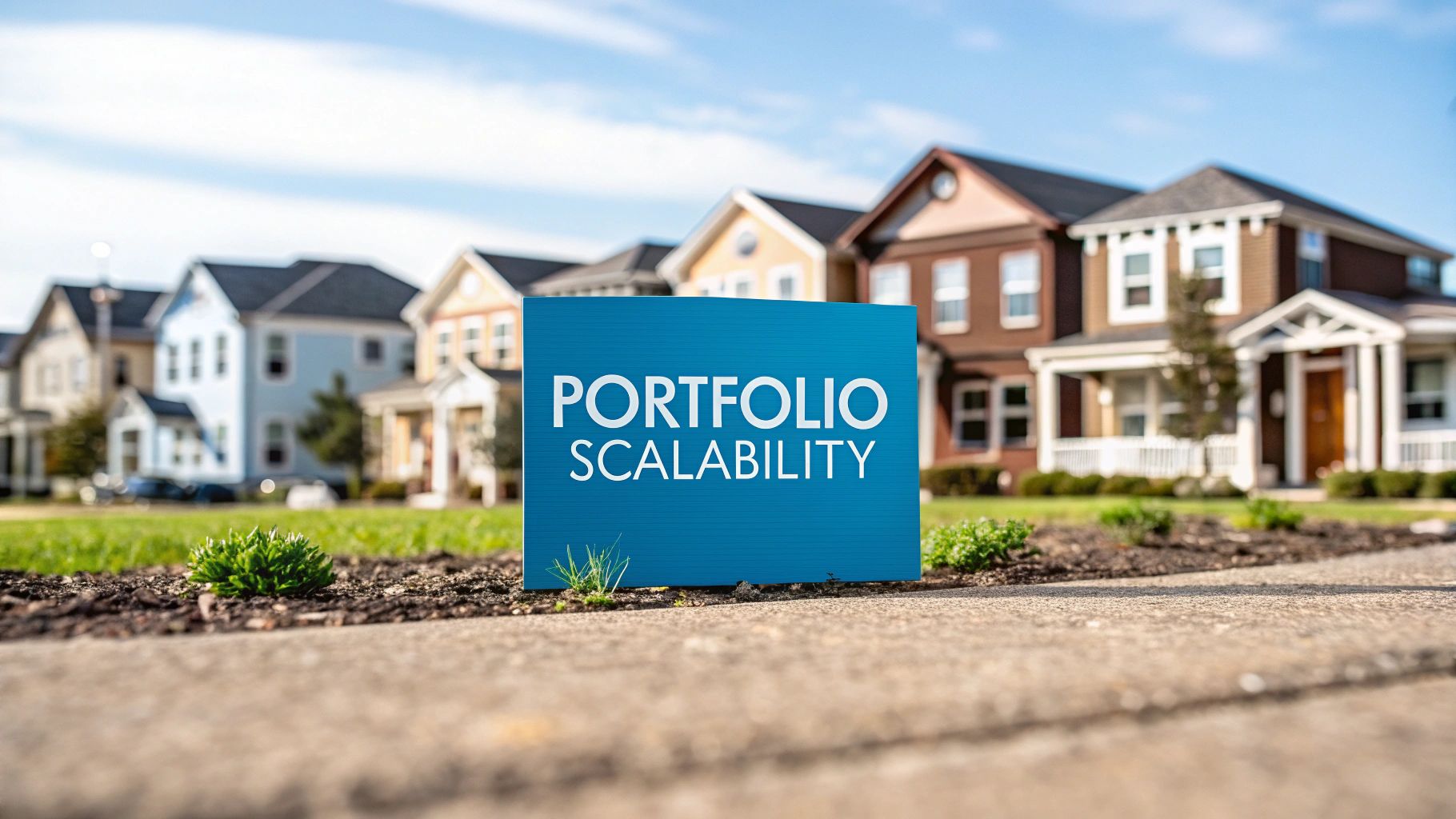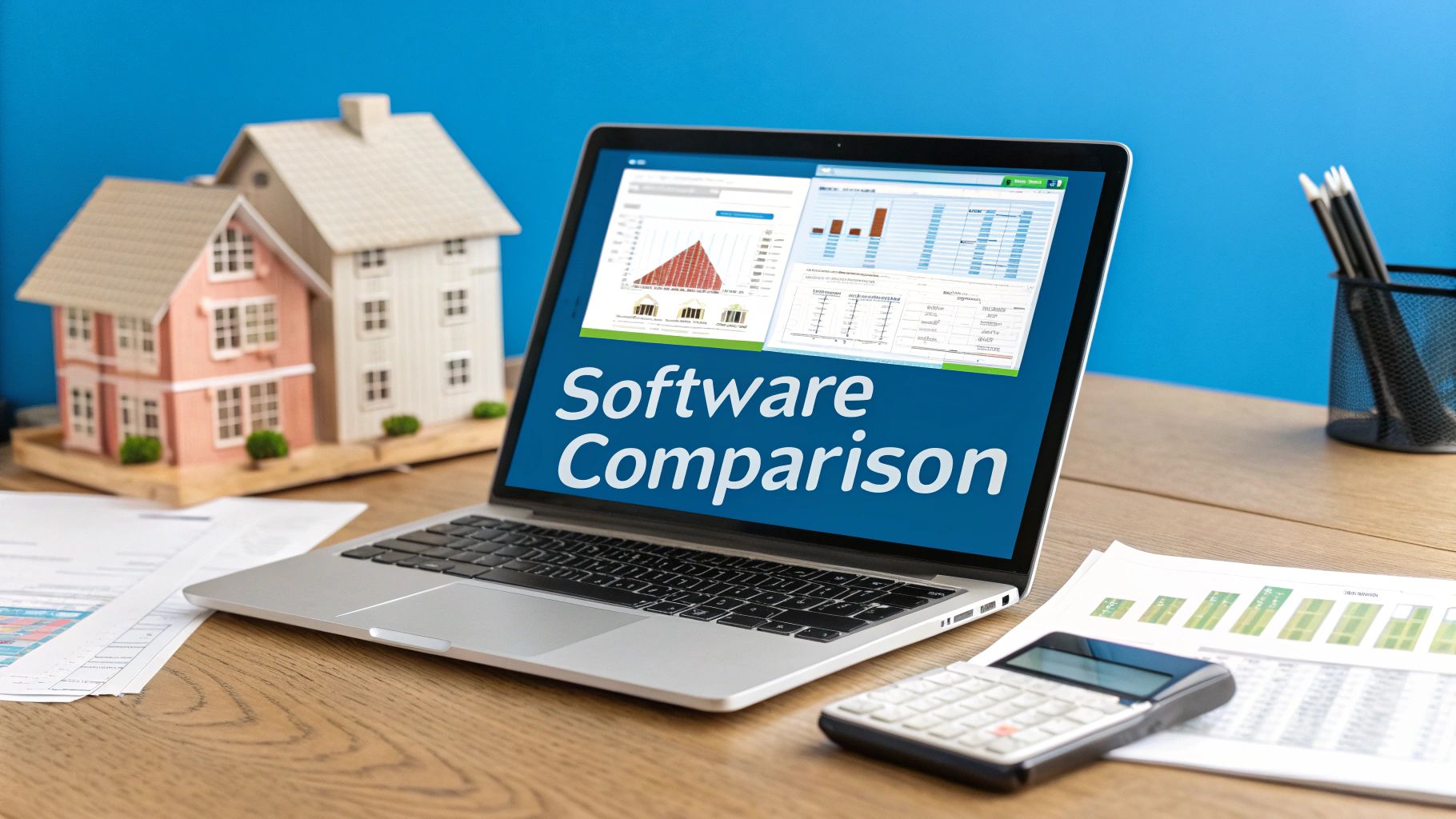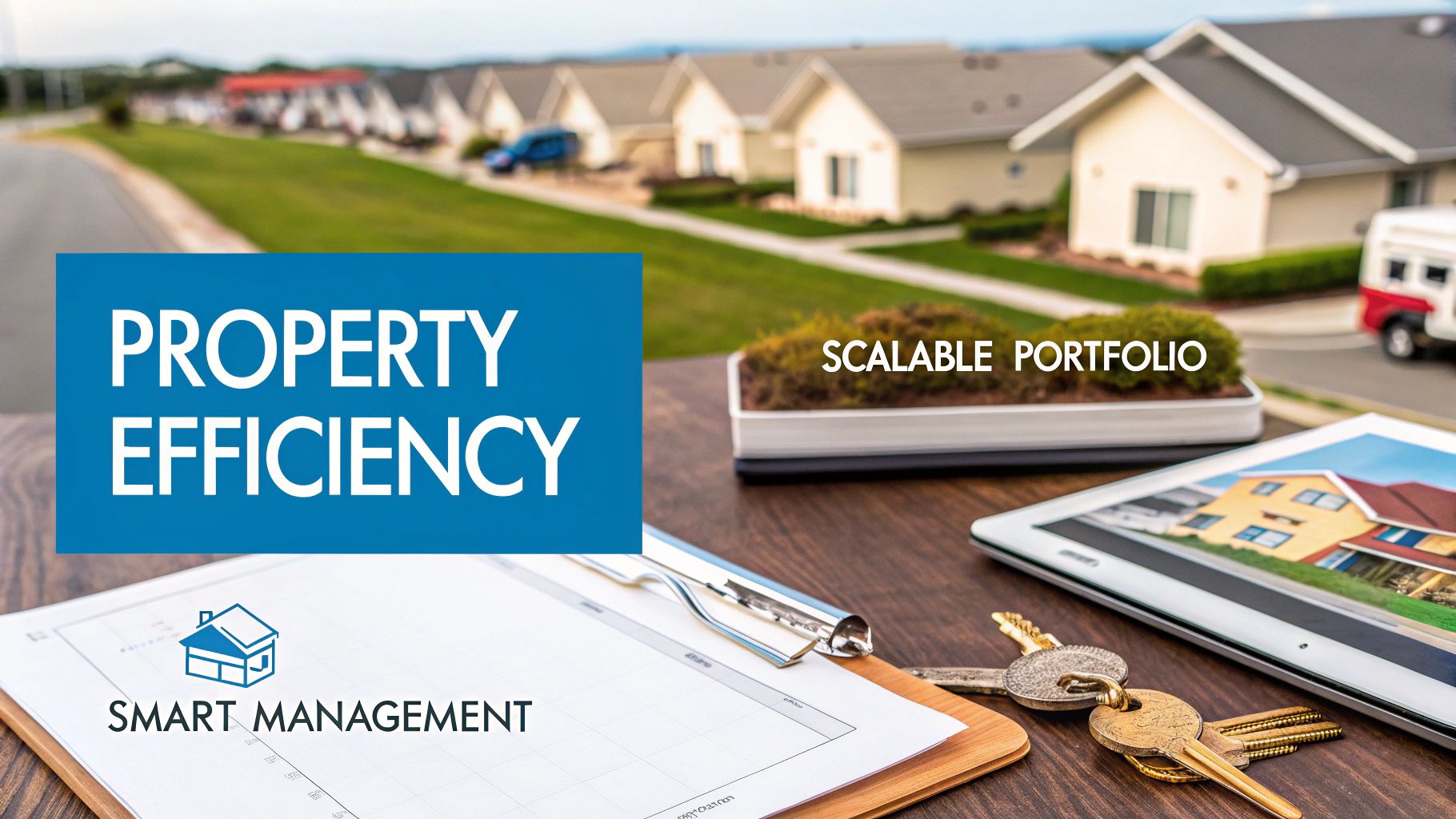For property management companies managing hundreds or thousands of units, the right investment strategy is about more than just acquiring assets. It’s about operational scalability and maximizing returns per door. While the standard buy-and-hold approach is a solid foundation, achieving true portfolio growth requires a more diversified and systemized methodology. To effectively scale and optimize critical metrics like Days on Market (DOM) and lead-to-tour conversion rates, operators must explore a variety of rental property investment strategies that align with enterprise-level goals.
The financial stakes are significant. For a 1,000-unit portfolio with an average rent of $1,500, a single extra day of vacancy across the portfolio represents a revenue loss of $50,000 per day. Shaving just three days off the average leasing cycle can add over $1.8 million back to the annual bottom line. This level of optimization demands strategies that are not only profitable but also repeatable and efficient at scale, directly impacting revenue recovery.
This guide moves beyond generic advice to explore nine proven rental property investment strategies, each reframed for the large-scale operator. We will dissect how each model can be systematized to reduce leasing friction, improve cost-per-door efficiency, and drive portfolio-wide financial performance. From the velocity of the BRRRR method to the high-yield potential of short-term rentals, you will learn how to implement these frameworks to build a more resilient, scalable, and profitable rental portfolio.
1. BRRRR Strategy (Buy, Rehab, Rent, Refinance, Repeat)
For enterprise-level operators, the BRRRR method is a high-velocity capital recycling strategy designed for rapid portfolio expansion. It’s a cyclical process that allows a firm to acquire and stabilize multiple properties using a finite pool of initial capital. This strategy transforms distressed assets into performing, cash-flowing units that can be integrated into a larger management system.
The process involves five distinct phases executed at scale:
- Buy: Systematically acquire distressed properties significantly below their potential after-repair value (ARV), leveraging market data and acquisition teams.
- Rehab: Implement standardized renovation scopes to force appreciation, focusing on improvements that deliver the highest ROI and appeal to the target renter demographic. This involves executing effective strategies to add value to real estate investments.
- Rent: The most critical phase for ROI. The goal is to minimize DOM by deploying an automated leasing process. Fast tenant placement is essential to prove the asset's income potential for refinancing.
- Refinance: Secure portfolio or commercial cash-out refinance loans based on the new, higher appraised values of a stabilized group of properties.
- Repeat: Re-deploy the extracted capital to fund the next wave of acquisitions and rehabs, continuing the growth cycle.
This infographic breaks down the core engine of the BRRRR method, illustrating how capital is recycled for portfolio growth.
The visualization highlights how each phase builds upon the last, culminating in the recovery of capital that fuels the next investment.
Keys to Scalable Implementation
Executing BRRRR at scale requires a robust operational framework. A widely used guideline is the 70% Rule: ARV × 0.70 – Repair Costs = Maximum Purchase Price. This formula ensures capital can be fully recovered during the refinance. Success at the enterprise level hinges on a systemized project management process, a network of vetted contractors, and lending relationships capable of handling portfolio loans. The speed of the "Rent" phase is paramount; a one-week delay in leasing across 20 properties can cost tens of thousands in lost revenue and holding costs. For an in-depth look at which upgrades provide the best return, you can learn more about rental renovations that pay off.
2. House Hacking
While traditionally an individual investor strategy, the principles of house hacking—acquiring small multi-family properties (2-4 units) using favorable financing and offsetting costs with rental income—can be systematized for portfolio growth. Large operators can implement programs to help employees or partners acquire these assets, adding them to the management portfolio. This creates a distributed, low-cost acquisition channel for desirable small multi-family assets.
This model allows a property management company to expand its footprint in a target market without the high capital outlay required for larger apartment buildings. The key is creating a repeatable framework for identifying properties, guiding the acquisition, and immediately integrating the new units into the existing leasing and management technology stack. This strategy is particularly effective for multi-market property management, enabling targeted growth in new regions.
Keys to Scalable Implementation
Success requires a shift from an individual to a programmatic mindset. The goal is to create a "house hacking as a service" model. This involves building a system to identify markets with a high inventory of duplexes and fourplexes where rents can cover the majority of PITI (principal, interest, taxes, insurance).
Key operational components for this strategy include:
- Standardized Underwriting: Develop a consistent model to analyze potential deals quickly, ensuring they meet cash flow and ROI thresholds for the management portfolio.
- Efficient Leasing Operations: Once acquired, these units must be leased quickly. Integrating them into a centralized showing system is critical to minimizing DOM and ensuring immediate revenue generation.
- Technology Integration: The new properties must plug directly into the company’s property management software (PMS) for seamless rent collection, maintenance, and reporting.
- Exit Strategy: The program should have a clear plan for each asset after the initial owner-occupancy period, typically converting it into a fully managed rental within the portfolio.
3. Short-Term Vacation Rentals (STR/Airbnb Strategy)
For operators managing portfolios in destination markets, a Short-Term Rental (STR) strategy can significantly increase revenue per door. This involves furnishing properties and renting them on a nightly or weekly basis through platforms like Airbnb and Vrbo. This approach often generates 2-3 times the gross revenue of a traditional long-term lease, but it comes with higher operational complexity.
This strategy transforms a residential property into a hospitality asset. The key to making it work at scale is systemization. For a portfolio of 100+ STRs, manual management of bookings, cleanings, and guest communication is impossible. Success depends on a robust tech stack and standardized operational procedures.
The image above captures the essence of a successful STR: a clean, inviting space designed to attract guests and earn positive reviews, which are crucial for sustained success.
Keys to Scalable Implementation
Success with STRs at scale requires a technology-first approach focused on automation and efficiency, not just hospitality. Before implementing, it's critical to weigh the pros and cons; you can explore a detailed breakdown of whether to Airbnb your property or not.
Key operational components include:
- Regulatory Compliance: Deploy a system to track and comply with local zoning laws, HOA rules, and municipal regulations across multiple jurisdictions, as these are complex and vary widely.
- Dynamic Pricing & Channel Management: Use software like PriceLabs and a channel manager to automate pricing based on demand and sync calendars across all booking platforms.
- Systemization of Operations: Automate guest communication, cleaning schedules (via platforms like Breezeway), and access control using smart locks and management software to create a scalable, remote operation.
- Data Analysis: Use data tools like AirDNA to analyze market demand, seasonality, and occupancy rates to inform acquisition and revenue management strategies.
- Team Building: Build a reliable, distributed team of cleaners and handymen managed through a central dispatch system to handle turnovers efficiently across a wide geographic area.
4. Turnkey Property Investing
From the perspective of a large property management company, turnkey investing is not about buying, but becoming the provider. This strategy involves creating an end-to-end system for acquiring, renovating, and stabilizing properties to sell to passive investors, with a long-term management contract attached. This creates two revenue streams: profit from the sale and recurring management fees.
The process is an operational assembly line:
- Acquisition & Rehab: A dedicated team sources and renovates properties to a standardized "turnkey" specification.
- Tenant Placement & Stabilization: The in-house leasing team uses an optimized, automated showing system to place a qualified tenant quickly, minimizing DOM and creating a cash-flowing asset.
- Sale to Investor: The stabilized property is sold to a passive investor, often from an out-of-state market.
- Ongoing Management: The property management company retains management, adding the door to its portfolio and generating long-term recurring revenue.
This model allows for controlled, systematic portfolio growth. For example, a company could aim to add 200 doors per year through this channel, creating a predictable pipeline of new management contracts. According to a 2024 report by the National Rental Home Council (NRHC), the demand for professionally managed single-family rentals continues to grow, validating this model.
Keys to Scalable Implementation
Success as a turnkey provider depends on operational excellence and building a reputation for reliability. The key is to build a seamless, repeatable process from acquisition to long-term management. This requires a high degree of systemization.
The most critical phase is tenant placement. A long vacancy period destroys the turnkey value proposition. Therefore, an automated leasing platform that enables same-day showings and rapid lead-to-tour conversion is essential. The ability to demonstrate a low DOM (e.g., under 14 days) becomes a powerful sales tool. Additionally, integrating the entire workflow—from acquisition tracking in a CRM to leasing automation and final onboarding into the PMS—is crucial for scaling this strategy profitably.
5. Buy and Hold Long-Term Rentals
The buy-and-hold strategy is the bedrock of large-scale property management. It involves acquiring properties, placing long-term tenants, and managing them for years to capture wealth through cash flow, appreciation, debt paydown, and tax benefits. For an enterprise, this isn't about single properties but about acquiring portfolios and optimizing their performance over time.
This strategy is about operational efficiency at scale:
- Buy: Acquire properties or entire portfolios in markets with strong economic fundamentals (job and population growth).
- Hold: Retain the assets for the long term (10+ years), focusing on operational improvements to increase Net Operating Income (NOI).
- Rent: Implement a best-in-class, technology-driven leasing engine to minimize vacancy loss across the portfolio.
- Optimize: Continuously analyze performance data to identify opportunities for expense reduction, rent growth, and ancillary income.
The success of this strategy at scale is measured in basis points of vacancy reduction and cents per square foot of NOI improvement. A 1% reduction in vacancy across a 5,000-unit portfolio can translate to hundreds of thousands of dollars in additional annual revenue.
Keys to Scalable Implementation
Executing a buy-and-hold strategy across thousands of units depends on scalable systems, not individual heroics. The goal is to standardize every operational process to drive efficiency and reduce cost-per-door. A key metric for screening acquisitions is often the 1% Rule, ensuring gross monthly rent is at least 1% of the purchase price, but at scale, sophisticated NOI and cap rate analysis is used.
The single biggest lever for performance is leasing velocity. Reducing DOM is the primary objective. This requires an automated leasing funnel that can handle thousands of leads, schedule tours 24/7 (whether in-person or self-guided), and convert prospects into applicants with minimal human friction. For more details on boosting your returns, explore these methods to maximize passive income from a rental property. Building a central leasing and maintenance operation that can serve a distributed portfolio is critical for profitable scaling.
6. Multi-Family Syndication
For large property management companies, multi-family syndication is a capital strategy for acquiring assets larger than they could afford alone. The property management company acts as the "General Partner" or "Sponsor," finding the deal, creating the business plan, and raising capital from passive "Limited Partner" investors.
The process functions through a partnership structure:
- General Partners (GPs): The property management company and its leadership team. They source the deal (e.g., a 150-unit apartment complex), secure financing, and manage all operations. They earn fees for acquisition, asset management, and a share of the profits.
- Limited Partners (LPs): Passive investors who provide the equity needed for the down payment and renovations. They receive a preferred return and a majority of the profits without management duties.
This strategy allows a property management firm to rapidly scale its door count and revenue. By syndicating a deal, the firm can earn significant fees and a disproportionate share of the profits, all while growing its core management business. This model has been used to build multi-billion dollar portfolios.
Keys to Scalable Implementation
Success as a syndicator hinges on a proven operational track record and the ability to execute a value-add business plan. Investors are betting on the GP's ability to increase the property's value. Therefore, the GP must demonstrate a clear, data-driven plan for increasing NOI.
Key components include:
- A Strong Leasing & Management Platform: The ability to show investors a technology-driven system for reducing vacancy, controlling expenses, and improving tenant experience is a key selling point.
- Conservative Underwriting: Use realistic assumptions for rent growth, vacancy rates, and exit cap rates. Over-promising and under-delivering can destroy a syndicator's reputation.
- Investor Relations: Implement a professional system for investor communication and reporting, providing regular updates on performance against the business plan.
- Legal and Financial Structure: Work with experienced securities attorneys to structure the deal correctly, ensuring compliance with all SEC regulations.
7. Live-In Flip Strategy
While an individual tactic, the "live-in flip" strategy can be leveraged by property management firms as a unique employee benefit and acquisition channel. The firm can create a program that educates and provides resources for its employees to execute this strategy: buy a property, live in it while renovating, and sell it for tax-free profit after two years, thanks to the Section 121 tax exclusion (up to $250k single/$500k married).
The company benefits in several ways:
- Employee Recruitment & Retention: A powerful perk that helps employees build personal wealth.
- Deal Sourcing: Employees on the ground can identify potential acquisitions for the company's main portfolio.
- "Farm Team" Development: It's a low-risk way to train employees in project management, budgeting, and value-add real estate principles.
- Management Pipeline: When an employee moves to their next live-in flip, their previous property can be added to the company's management portfolio.
This method transforms a personal wealth-building tool into a scalable program for talent development and portfolio growth, creating a loyal, financially savvy team.
Keys to Scalable Implementation
To institutionalize this strategy, the company must create a formal program. The key is to provide a structured framework and resources to ensure employee success and alignment with company goals. This includes offering training on finding deals, estimating renovation costs, and project management.
The company could provide access to its network of vetted contractors and vendors, offer preferred financing connections, and create standardized renovation checklists that focus on the highest ROI improvements (kitchens, baths, curb appeal). The program must emphasize meticulous record-keeping for tax purposes. By creating a repeatable system, the company can turn this into a predictable source of new management contracts and a highly valuable part of its corporate culture.
8. Rent-to-Own (Lease Option) Strategy
For large portfolio owners, the rent-to-own or lease option strategy is a powerful disposition and tenant stabilization tool. It is particularly useful for assets in slower-moving markets or for B/C-class properties that the company plans to eventually sell. It involves offering tenants the option to purchase the property at a predetermined price after a set lease period.
This strategy enhances a property's financial performance in three ways:
- Option Fee: The tenant-buyer pays a non-refundable upfront fee (2-5% of the purchase price), which immediately boosts cash flow and reduces the risk of default.
- Premium Rent: The monthly rent is often set above market rate, with a portion credited toward the tenant's future down payment, increasing monthly revenue.
- Reduced Turnover & Maintenance: Tenant-buyers are incentivized to maintain the property as if it were their own, significantly reducing maintenance costs and turnover expenses—a major benefit for cost-per-door metrics.
At scale, a property management company could designate 5-10% of its portfolio for a lease-option program, creating a new revenue stream and a predictable pipeline of property sales.
Keys to Scalable Implementation
Executing a lease-option program across a large portfolio requires standardization and strict legal compliance. The goal is to create a turnkey program that can be offered to qualified residents.
Key steps include developing a rigorous screening process to identify tenants with a realistic path to obtaining a mortgage. This may involve partnering with mortgage brokers or credit counseling services. It is essential to work with real estate attorneys to create a standardized, ironclad lease-option agreement that is compliant in every state of operation. This agreement must clearly define the purchase price, option period, and handling of maintenance responsibilities. A centralized system to track option fees and rent credits is also necessary for accurate accounting and reporting.
9. Fix and Flip
For large-scale operators, a fix-and-flip division functions as a capital-generating engine to fuel the core buy-and-hold portfolio. This active strategy involves acquiring distressed properties, executing rapid, standardized renovations, and selling them for a profit, typically within 6-12 months.
The fix-and-flip process is a high-velocity manufacturing line:
- Acquisition: A dedicated team uses data and market connections to source undervalued properties at scale.
- Renovation: A project management system manages dozens of simultaneous renovations, using standardized scopes of work and a network of contractors to control costs and timelines.
- Marketing & Sale: The properties are quickly listed and sold. The speed of sale is critical to maximizing annualized returns.
Unlike long-term rentals, flipping is about the velocity of capital. The profits generated are then redeployed to acquire more stable, cash-flowing rental assets for the main portfolio, creating a self-funding growth loop.
Keys to Scalable Implementation
Scaling a flipping operation requires an obsessive focus on systems and metrics. The most critical formula is the 70% Rule: (ARV × 0.70) – Repair Costs = Maximum Purchase Price. Adhering to this rule on every deal provides a necessary buffer for unforeseen costs and ensures profitability.
Success at scale demands a technology-driven project management platform to track budgets, timelines, and contractors across the entire pipeline. Building a reliable team of contractors is paramount. Furthermore, sophisticated operators have multiple exit strategies. If a flipped property doesn't sell quickly, it can be seamlessly moved into the rental portfolio and leased using the company's efficient leasing system to cover carrying costs—a crucial backstop that mitigates market risk.
9 Rental Investment Strategies Comparison
Systematizing Your Strategy for Enterprise-Level Success
The journey into real estate is paved with diverse and powerful rental property investment strategies. We've explored a wide spectrum of approaches, from the high-velocity BRRRR method to the passive-income engine of a turnkey operation. Each strategy offers a unique pathway to building a scalable, profitable portfolio. However, for property managers operating at an enterprise scale, the choice of strategy is only the first chapter. The true determinant of success, the factor that separates moderate returns from market-leading performance, is the systemization of your leasing operations.
At an enterprise level, managing hundreds or thousands of scattered-site properties demands a robust operational framework that can consistently minimize vacancy loss—the single largest controllable drain on revenue. The core challenge is not which strategy to choose, but how to deploy an efficient leasing engine across a large, often geographically dispersed portfolio, without a proportional increase in operational overhead.
From Individual Tactics to a Scalable Leasing Engine
The key to unlocking enterprise-level profitability lies in transforming your leasing process from a manual, people-dependent function into a repeatable, technology-driven system. The leasing funnel—from initial lead to signed lease—is the most significant bottleneck and the greatest opportunity for optimization. A vacant day for a single property is a minor loss; a vacant day multiplied across a 5,000-unit portfolio is a catastrophic revenue leak. This is where strategic systemization becomes paramount.
Consider the operational demands of the strategies discussed:
- BRRRR and Fix-and-Flip: The final, most crucial step is securing a tenant or buyer. Every day a property sits on the market post-renovation directly erodes the project's ROI. Reducing DOM is critical.
- Buy and Hold & Turnkey: The long-term profitability of these strategies is directly tied to minimizing vacancy rates and turnover time. A 5% reduction in vacancy can increase NOI by over 10%.
- Short-Term Rentals: Success hinges on maximizing occupancy, which requires a seamless, instant booking and showing experience for prospective guests.
In every scenario, speed-to-lease is the central performance metric. Legacy methods of coordinating showings—phone tag with agents, manual lead follow-up—simply do not scale. They create friction, extend Days on Market (DOM), and result in lost revenue as high-intent renters choose more responsive competitors.
The Force Multiplier: Leasing Automation
This is where a dedicated leasing automation platform becomes a non-negotiable component of an enterprise tech stack. By centralizing and automating lead response, tour scheduling, and agent dispatch, you can build a system that executes flawlessly 24/7, regardless of portfolio size. The goal is to create an environment where a qualified lead can schedule a tour within minutes of their initial inquiry. This level of efficiency directly impacts the bottom line by drastically reducing DOM and improving lead-to-tour conversion rates.
Ultimately, the most effective rental property investment strategies for large-scale operators are those underpinned by a scalable, automated, and metric-driven leasing engine. The true competitive advantage is not just in identifying great properties but in building a superior operational machine that fills them faster and more efficiently than anyone else. This focus on systemization elevates your portfolio from a collection of individual assets into a high-performance, revenue-generating enterprise.
Ready to transform your leasing operations from a manual bottleneck into a scalable, automated engine? Showdigs provides the on-demand showing agent network and automated scheduling software that enables enterprise-level property managers to slash Days on Market and convert leads faster. See how our platform can systematize your leasing process and maximize your portfolio's profitability by visiting Showdigs today.







